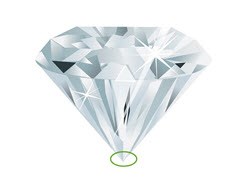Diamond Culet and its Effect on Grading
The grading of a diamond is based on several factors – from clarity to weight and cut, as well as color. The diamond culet – the tiny area at the base of the stone’s pavilion - also affects a diamond grading and ultimately its worth.

The culet can be a point or a small facet that sits parallel to the table. When a diamond is sent for certification, expert gemologists view the diamond face up to determine the culet's size, and from the side to determine the angle of the culet. Culet sizes are determined by the GIA, which uses the following scale:
- None
- Very Small
- Small
- Medium
- Slightly Large
- Large
- Very Large
- Extremely Large
According to the GIA, a diamond should not weigh more than its face-up appearance warrants, and its proportions should not increase the risk of damage when set in jewelry. Any culet smaller than a “Medium” is invisible to the naked eye, and therefore has no negative impact on the appearance of the diamond. However, by allowing light to enter from the crown and pass through the culet’s facet, any culet larger than a “Slightly Large” might reduce the diamond’s brilliance.
If there is no culet facet, the size is reported as “None”. When the culet is at more than a slight angle to the table facet, the grader also reports the culet size as “None”, as it is no longer considered a culet but an extra facet of the stone. The grader also assesses the clarity of the culet. If any chips or cavities, for instance, are present at the culet, only the remaining portion of the culet facet is considered when assessing culet size. The culet may also be left as an unpolished natural surface. If the culet is nearly parallel to the table facet, it is still considered a culet and assigned an appropriate size description. While abrasions may not affect the culet size, they do prevent a clarity grade of Flawless, and are also considered in the diamond’s polish assessment.

